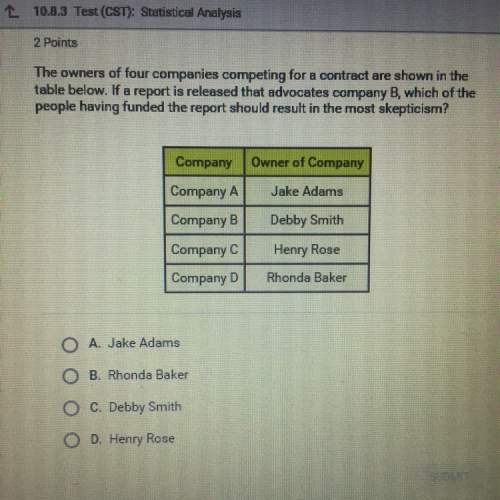
Mathematics, 12.08.2020 08:01 oliviaschmitt0
△ABCis reflected to form △A′B′C′. The vertices of △ABC are A(-1, 3), B(2, 4), and C(-5, 6). The vertices of △A′B′C′ are A′(3, −1), B′(4, 2), and C′(6, −5). Which reflection results in the transformation of △ABC to △A′B′C′? Reflection across the x-axis reflection across the y-axis reflection across y = x reflection across y=−x

Answers: 2


Another question on Mathematics

Mathematics, 21.06.2019 21:30
Complete each statement from the information given and the triangle criterion you used. if the triangles cannot be shown to be congruent, leave the box for the second triangle blank and choose for reason “cannot be determined.” carbon - regular hexagon. ∆can ≅ ∆ by
Answers: 1

Mathematics, 22.06.2019 02:30
Ken earned $128 from his part-time job this summer. he spent 25% of his money on games. he is going to donate 1/6 of the remaining money to charity. how much money will the charity receive?
Answers: 1

Mathematics, 22.06.2019 03:00
Your friend, taylor, missed class today and needs some identifying solutions to systems. explain to taylor how to find the solution(s) of any system using its graph.
Answers: 1

Mathematics, 22.06.2019 04:00
Alakefront cottage that is 30 feet high casts a shadow on the water. how long is that shadow if a 16-foot-high truck parked nearby casts an 8-foot shadow?
Answers: 1
You know the right answer?
△ABCis reflected to form △A′B′C′. The vertices of △ABC are A(-1, 3), B(2, 4), and C(-5, 6). The vert...
Questions


Biology, 11.05.2021 19:50



Mathematics, 11.05.2021 19:50

Mathematics, 11.05.2021 19:50

Mathematics, 11.05.2021 19:50










Mathematics, 11.05.2021 19:50






